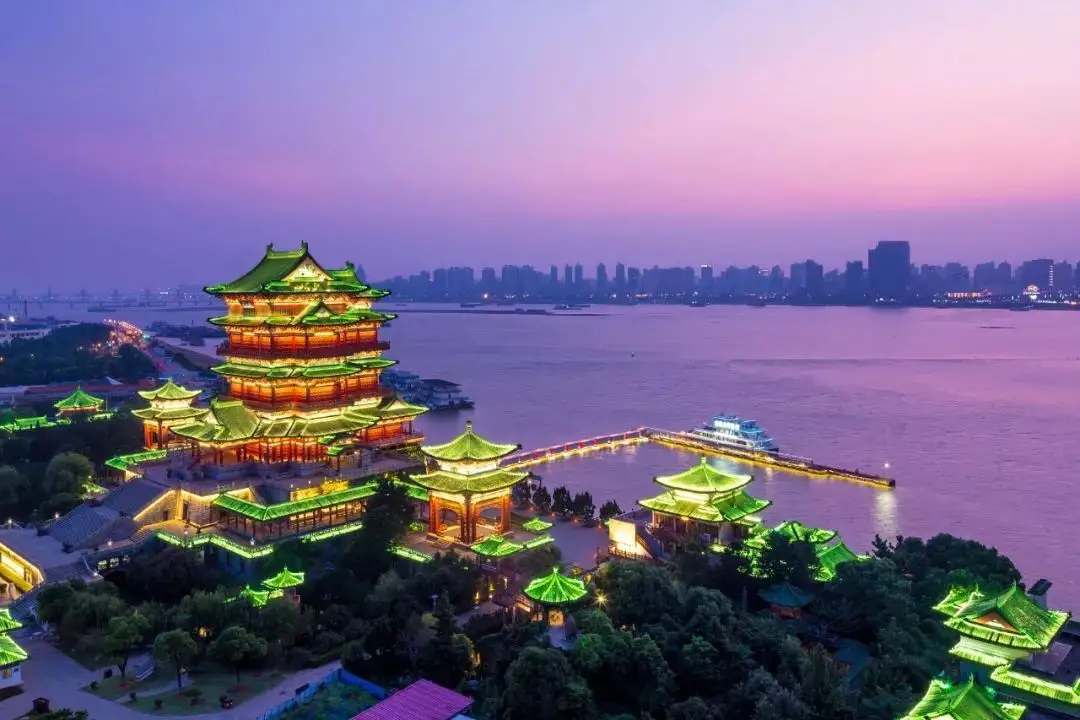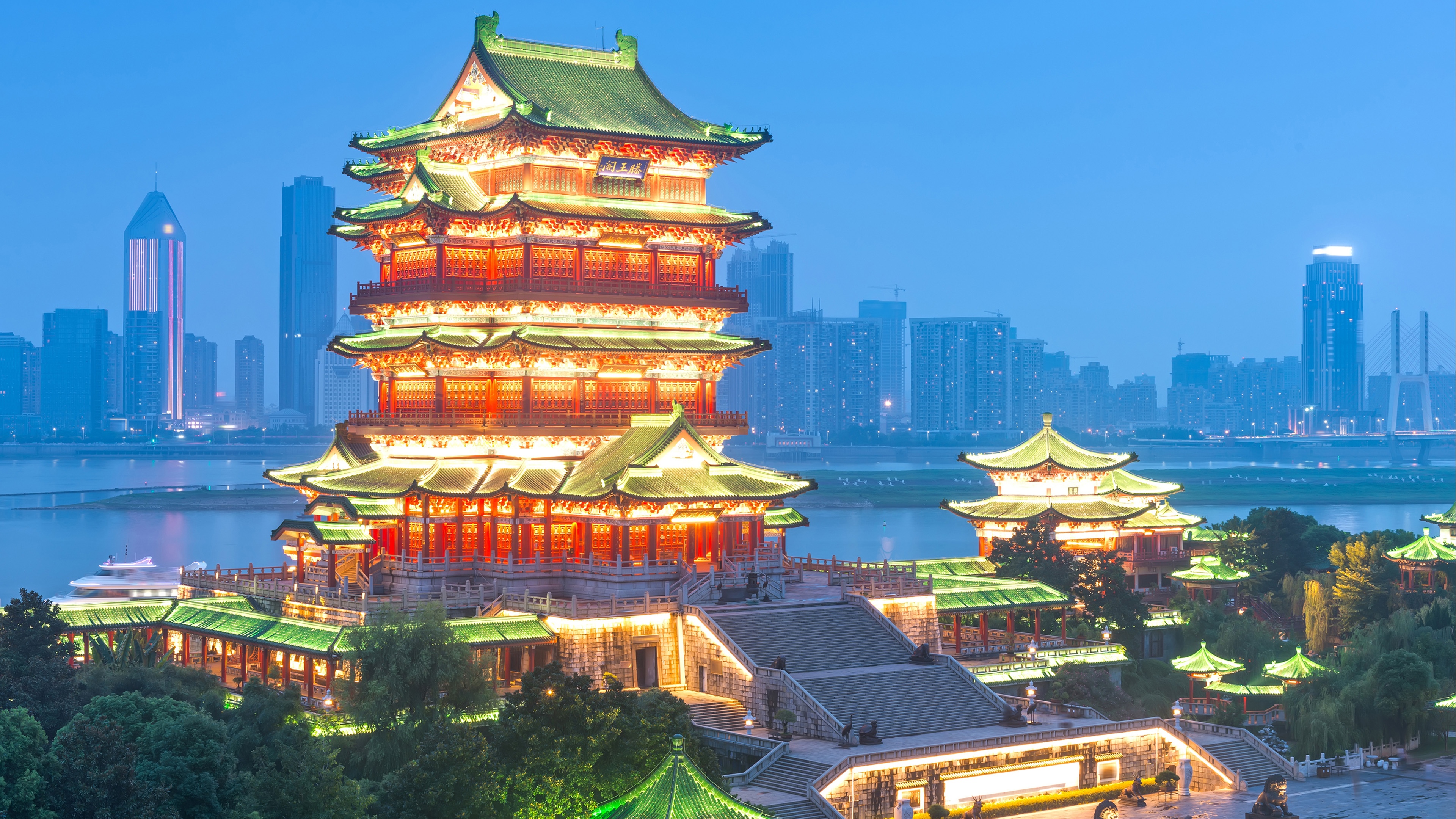Overview
Chinese Name: 滕王阁
English Name: Tengwang Pavilion;Pavilion of Prince Teng;Teng Wang Ge
Location: Nanchang, Jiangxi
Type: Ancient culture and art
Rating Level: AAAAA (5A)

Brief Introduction
Pavilion of Prince Teng, located in Nanchang City, Jiangxi Province, located on the east bank of the Ganjiang River 赣江(one of the main tributaries of the Yangtze River 长江), is a landmark building in Nanchang City, a symbol of the ancient civilization of Yuzhang 豫章, was built in the fourth year of Tang Yonghui 永徽 (653), and was built by Li Yuanying 李元婴, the brother of Taizong of Tang 唐太宗, when he was the governor of Hangzhou, and the existing building was rebuilt in 1985.
Tengwangge is famous for the “Preface to the Pavilion of Prince Teng 滕王阁序” written by the early Tang Dynasty poet Wang Bo 王勃; Together with Yueyang Tower 岳阳楼 in Hunan and Yellow Crane Tower 黄鹤楼 in Wuhan, Hubei, it is known as the “Three Famous Buildings of Jiangnan” and is one of the four famous buildings in ancient China.

The main building of Tengwang Pavilion is 57.5 meters high and has a construction area of 13,000 square meters; its lower part is a 12-meter-high pedestal symbolizing the ancient city wall, divided into two levels; the main pavilion above the pedestal takes the format of “three shades of light” and is a three-story corridor building, with a total of seven floors inside, divided into three bright floors, three dark layers, and attics; The orthogonal snout is made of imitation Song dynasty and is 3.5 meters high.
In 2004, the Tengwangge Tourist Zone in Nanchang City, Jiangxi Province, including Tengwangge, was approved by the State Council to be included in the list of the fifth batch of national key scenic spots. On October 29, 2018, the Tengwangge Tourist Area in Nanchang City, Jiangxi Province, including Tengwangge, was officially approved as a national AAAAA-level tourist attraction by the National Tourism Scenic Spot Quality Rating Committee.

What are worth visiting and seeing?
Architectures
The main building of Tengwang Pavilion is 57.5 meters high and has a construction area of 13,000 square meters; its lower part is a 12-meter-high pedestal symbolizing the ancient city wall, divided into two levels; the main pavilion above the pedestal is a three-story back corridor imitation Song style building, with a total of seven floors, divided into three bright floors, three dark floors, and an attic. On the wall of the main hall on the second floor is a large acrylic mural “Renjie Tu”人杰图, which is 2.55 meters high and more than 20 meters long.
The hook head and dripping water are specially made of wading, the hook head is the four characters of “Tengge Autumn Wind”滕阁秋风, and the dripping water is the “Lone Bird”孤鹜 pattern; Under the pedestal, there are two scoop-shaped artificial lakes connecting the north and south, and there is a Jiuqufengyu Bridge 九曲风雨桥 built on the north lake.

Above the first-level high platform is the second-level high platform (city wall platform), which has three entrances from the high platform to the pavilion, and the east climbing stone level enters the pavilion through the Baoxia 抱厦, and the north and south sides enter the pavilion from the high and low corridors. In front of the east hug, there is a bronze cast “Eight Monsters” Ding(cauldron) 八怪宝鼎, the Ding seat is made of white jade, the height of the Ding is about 2.5 meters, the lower part is a three-legged ancient Ding, and the upper part is a dome-style lid with a pointed treasure roof.

The paintings on the beams 梁枋彩画 in the main pavilion adopt the Song-style paintings of “Jade Style”碾玉装 as the main tone, supplemented by “Multicolored Decoration”五彩遍装 and “Unraveling Green Knot Style”解绿结华装. All indoor and outdoor beams and fangs are equipped with “Jade Style” in each room, and “colorful decoration” is used in each room.

In terms of organizing space, arranging space, and expanding space, Tengwangge creatively solved a series of problems in sound, shadow, light, and color, thus producing a special artistic conception. It fully embodies the aesthetic characteristics of classical Chinese architecture and interweaves a gorgeous and unpredictable landscape picture through the integration of the imaginary scene and the real scene.
Looking at it horizontally, the Tengwangge complex forms the order of the arrangement of pavilions, galleries, and pavilions, and the artistic treatment of the group buildings produces various different ways according to the nature and scale of the group.

The main building of the Tengwang Pavilion is the pavilion itself, which forms a musical-like rhythmic sense by connecting with the subordinate pavilions, the Yajiang pavilion 压江亭, and the Yicui Pavilion 挹翠亭, as well as the cloister that plays a connecting role, giving visitors the beauty of music.
History and culture
Tengwang Pavilion was regarded as an auspicious Feng shui 风水 building in ancient times, and it is said that if Tengwang Pavilion and Shengjin Pagoda 绳金塔 collapse, the talents, and treasures in Yuzhang City will be lost, and the city will also fall and no longer prosper.
In ancient Chinese customs, feng shui buildings were needed in populated areas, generally the highest local landmarks. Located on the banks of the Ganjiang River, Tengwang Pavilion was known as the “water pen” by the ancients and was used to pray for blessings. It can be seen that the Tengwang Pavilion occupies a sacred position in the minds of the locals, and all the dynasties and dynasties have been valued and protected.

At the same time, the Tengwang Pavilion is also a place for ancient storage of scriptures and historical texts, in a sense an ancient library. Ancient officials welcomed and entertained guests. Literati would fill in poems here and watch the night scene.

Pavilion of Prince Teng滕王阁
You might be interested in: